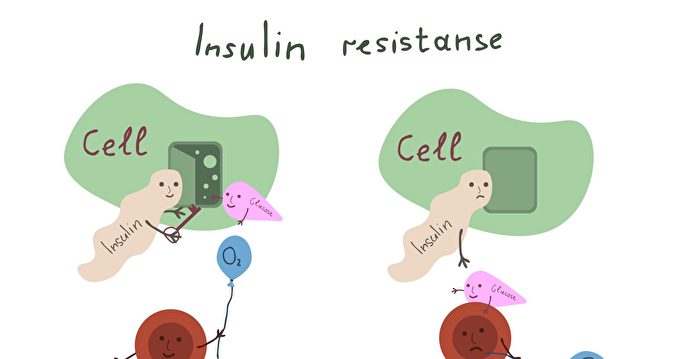Insulin acts like a key, opening the door for glucose to enter cells. The culprit of diabetes and fatty liver may be insulin resistance! Do not ignore these symptoms in your body. (elyomys/Shutterstock)
If you often feel tired, have a dry mouth, and need to go to the bathroom frequently, a hidden health killer may be eroding your health: insulin resistance. It is also the culprit of diabetes, fatty liver, and even tumors. Don’t ignore these symptoms in your body!
Insulin is a hormone secreted by the islet cells of the human pancreas. Its function is to transport the glucose produced after digesting our food from the blood into the cells to provide energy for the cells. In other words, insulin is the body’s energy carrier.
The so-called insulin resistance means that cells are no longer sensitive to insulin, which means that after the same amount of insulin comes into contact with cells, they can no longer effectively transfer glucose into cells.
Symptoms of insulin resistance are often subtle, making it difficult for people to connect symptoms such as fatigue, dry mouth, and excessive urination to insulin resistance, making the disease difficult to detect. That’s why it’s called the invisible killer.
Another reason why insulin resistance is called the “silent killer” is that it is very harmful to health. Because our body cells require glucose to provide energy, if the glucose in the blood cannot be converted into energy within the cells in time, our body functions will be affected.
In addition, too much glucose in the blood can lead to other health problems, especially metabolic problems, such as fatty liver, diabetes, and even chronic inflammation, which can further lead to various immune diseases and tumors.
It can be seen that insulin resistance is indeed a “hidden killer” of health.
Risk factors affecting insulin sensitivity
So what factors can cause cells to become insensitive to insulin?
First,obesity. Visceral fat, especially around the abdomen and organs, is a major cause of insulin resistance.
ResearchIt was found that adolescents have lower subcutaneous fat production capacity, more visceral fat, relatively poor sensitivity to insulin, and higher blood sugar 2 hours after a meal.
second,inflammation。 research shows, chronic inflammation is one of the important factors inducing insulin resistance. Obesity increases inflammation because fat cells secrete pro-inflammatory factors.
third,mental stress. When people are under great mental stress, they will produce too much glucocorticoids, also known as “stress hormones.” This hormone can easily cause central obesity. Chronic stress can also exacerbate the inflammatory response in the body.
fourth,genetics. Genetic factors may also trigger insulin resistance, which we cannot change. If there is a history of diabetes in the family, the risk of insulin resistance is also greater.
However, the human body has a mechanism for regulating genetic expression calledMethylation, can change the genetic expression without changing the DNA sequence, so that some bad genes will not be expressed. Factors such as exercise, diet, sleep and stress can affect gene methylation, and these factors are within our control.
Researchfound that after 8 weeks of physical activity in sedentary volunteers, their fasting insulin levels were reduced by 60%, and 103 DNA methylation changes were found in their skeletal muscles, including those related to metabolic disease and inflammation. , the degree of methylation of obesity-related genes increases, which means that the expression of this gene decreases.
Insulin resistance and type 2 diabetes
Insulin resistance is a warning that your body is on the path to developing diabetes. When cells are insensitive to insulin, the body has to secrete more insulin. Over time, the pancreatic islets will tire and cannot produce enough insulin. This is when diabetes occurs.
So what are the signs that you might have insulin resistance? In addition to diabetic symptoms such as dry mouth, frequent urination, and easy fatigue, the most alarming phenomenon is abdominal obesity. If your waist circumference exceeds 40 inches for men and 35 inches for women, you may have insulin resistance. In addition, having conditions such as chronic kidney disease, fatty liver disease, and polycystic ovary syndrome also means a higher risk of insulin resistance.
Insulin resistance detection method
In addition to analyzing our own symptoms, we can also diagnose insulin resistance through medical testing:
method one,Fasting blood glucose test. If your fasting blood sugar reading exceeds 100 mg/dL but does not meet the criteria for diabetes, it may indicate insulin resistance.
Method two,Blood insulin level testing. Because insulin sensitivity is reduced, the body produces too much insulin, so if insulin levels in your blood are outside the normal range, you may have insulin resistance.
Method three,glucose tolerance testthat is, two hours after ingesting a certain amount of sugar, the degree of increase in blood sugar and the level of insulin secretion are measured.
Once we understand this knowledge, we can take a series of measures, including diet, sleep, exercise, and reducing stress, to reverse insulin resistance before it progresses to diabetes. @
Watch the video:
In this chaotic world, if you want to be healthy, look at Health 1+1!
Editors in charge: Zhang Xiaohui, Li Fan
2023-10-09 22:18:29
#Insulin #resistance #culprit #fatty #liver #disease #diabetesDont #ignore #symptoms #Invisible #killer #Epoch #Times


